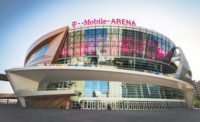
Concern for public safety at Brooklyn's Barclays Center—after the discovery that mostly under-strength bolts were used in the facade's prefabricated facade assemblies—was allayed soon after the error's discovery last August, says the curtain wall inspector. Even so, this week, the arena's curtain-wall fabricator is finishing up a fix that replaced 1,768 of the 23,351 bolts.
"There is a tremendous amount of redundancy," says Israel Berger, CEO of the New York City-based curtain wall consultant, Israel Berger & Associates. IBA is the special inspector for the arena's curtain wall.
"You would have to have so many events happening at one time in one spot to reach the capacity of the bolts, let alone exceed it," says Berger. Even then, assembly components would overdeflect, not break, he adds.
Barclays opened Sept. 28 and the assemblies weathered Superstorm Sandy. IBA says it alerted the city's Dept. of Buildings to the mix-up and the fix on Sept. 5 in its report for a temporary certificate of occupancy. DOB spokesman, Anthony Sclafani, says DOB was not alerted, as it would have expected.
The facade has a latticework of 12,000 dissimilar pre-weathered steel panels. At the fabricator ASI Ltd.'s plant, groups of panels were to be bolted via angles and braces to either a curtain wall panel or a support frame. Part way through the job in late 2011, ASI defaulted financially. Its surety took over, hiring FacadeTek to finish (ENR 7/16/12 p. 20).
Curtainwall Design Consulting, Dallas, ASI's engineer-of-record, found the error after most assemblies were installed. "ASTM A307 Grade A (A307-A) 5/8-in.-dia bolts were used instead of ASTM A325 5/8-in.-dia bolts" on the steel that frames the latticework to the curtain wall panels, says CDC's John D. Nelson, in a Dec. 5, 2012 letter to Fasano Acchione & Associates. The firm is managing the job for ASI's surety. Neither would comment.
Wind tunnel tests in 2010 assumed the facade was an airtight skin, not shingle-like panels hung outside the wall with air between, says Berger. Wind pressures are lower on the system than on a skin, he adds.
That's in part why, after an investigation based on modified assumptions, CDC determined the lower-strength A307 bolts were acceptable in many, though not all, locations. "Members with tension or compression from environmental load combinations that exceed the allowable shear of 3,450 lb were designated for replacement," says Nelson, in the letter. CDC did not return calls for comment.
Most of the fix involves the entrance canopy bolts, says Jeff Fisher, contract manager for the arena's design-build contractor, the local office of Hunt Construction Group.
Local arena developer Forest City Ratner Cos. downplays the error, calling it a punchlist item. It also says it is too early for litigation. "It is hard to separate the bolt issue from the ASI bankruptcy, which also had schedule implications," says Robert P. Sanna, FCRC's director of construction. "We continue to assess cost and damage impacts. "



Post a comment to this article
Report Abusive Comment